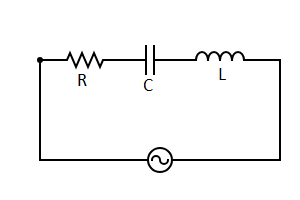
In the given circuit the phase difference between voltage across R and voltage across C is

(A) zero
(B) $\dfrac{\pi }{2}$
(C) $\pi $
(D) $\dfrac{{3\pi }}{2}$
Answer
217.8k+ views
Hint: In an RC ac circuit it is better to draw the phase diagram. It gives a better understanding of phase angles.
Complete step by step solution:
The phase diagram for an ac circuit tells us about the phase angle of current and voltage. It is usually drawn for an RC circuit, RL circuit, LC circuit and RLC circuit. In it we usually find the phase angles of currents flowing through all the elements of the circuit with respect to current through the resistor.
The circuit given in the question is an RLC circuit.
This circuit will have some reactance along with resistance. Also it will not have an equivalent resistance but an equivalent impedance (Z).
This phase difference $\phi $ depends upon the reactive value of the components being used and hopefully we know that reactance, (X) is zero if the circuit element is resistive, positive if the circuit element is inductive and negative if it is capacitive.
Now let’s say that, for current through R, the instantaneous current will be given by;
$i = {i_0}\sin (\omega t)$ (${i_0}$is the maximum value of the current)
Also, instantaneous voltage will be;
${v_r} = {v_0}\sin (\omega t)$ (${v_0}$ is the maximum value of voltage) ---------eq. (1)
But for capacitor the value of instantaneous charge in the capacitor will be;
$q = {q_0}\sin (\omega t) = C{v_0}\sin (\omega t)$ (${q_0}$ is the maximum charge)
Thus by differentiating the above equation with respect to time we get;
${i_c} = C{v_0}\omega \cos (\omega t)$ (${i_c}$ is the instantaneous current through the capacitor)
Hence instantaneous voltage across capacitor is given by;
${i_c}{X_c} = {v_c} = {v_0}\sin (\omega t + \dfrac{\pi }{2})$ -----eq. (2)
From equation: 1 and equation: 2 we get that the angle between the phase of voltage across resistance and phase of voltage across capacitor is 90 degree.
In an ac RLC circuit the instantaneous current through the resistor and voltage across resistor are in phase. But the voltage across the capacitor lags by 90 degrees. The diagram below shows the angle between voltage across resistor and voltage across capacitor is 90 degree.
Hence option (B) is correct.
Note:
1. Voltage across the inductor leads by 90 degrees from voltage across the resistor.
2. Voltage across resistor and current across resistor are in phase.
3. Angle between the phases of voltage across the inductor and voltage across the capacitor is 180 degrees.
Complete step by step solution:
The phase diagram for an ac circuit tells us about the phase angle of current and voltage. It is usually drawn for an RC circuit, RL circuit, LC circuit and RLC circuit. In it we usually find the phase angles of currents flowing through all the elements of the circuit with respect to current through the resistor.
The circuit given in the question is an RLC circuit.
This circuit will have some reactance along with resistance. Also it will not have an equivalent resistance but an equivalent impedance (Z).
This phase difference $\phi $ depends upon the reactive value of the components being used and hopefully we know that reactance, (X) is zero if the circuit element is resistive, positive if the circuit element is inductive and negative if it is capacitive.
Now let’s say that, for current through R, the instantaneous current will be given by;
$i = {i_0}\sin (\omega t)$ (${i_0}$is the maximum value of the current)
Also, instantaneous voltage will be;
${v_r} = {v_0}\sin (\omega t)$ (${v_0}$ is the maximum value of voltage) ---------eq. (1)
But for capacitor the value of instantaneous charge in the capacitor will be;
$q = {q_0}\sin (\omega t) = C{v_0}\sin (\omega t)$ (${q_0}$ is the maximum charge)
Thus by differentiating the above equation with respect to time we get;
${i_c} = C{v_0}\omega \cos (\omega t)$ (${i_c}$ is the instantaneous current through the capacitor)
Hence instantaneous voltage across capacitor is given by;
${i_c}{X_c} = {v_c} = {v_0}\sin (\omega t + \dfrac{\pi }{2})$ -----eq. (2)
From equation: 1 and equation: 2 we get that the angle between the phase of voltage across resistance and phase of voltage across capacitor is 90 degree.
In an ac RLC circuit the instantaneous current through the resistor and voltage across resistor are in phase. But the voltage across the capacitor lags by 90 degrees. The diagram below shows the angle between voltage across resistor and voltage across capacitor is 90 degree.
Hence option (B) is correct.
Note:
1. Voltage across the inductor leads by 90 degrees from voltage across the resistor.
2. Voltage across resistor and current across resistor are in phase.
3. Angle between the phases of voltage across the inductor and voltage across the capacitor is 180 degrees.
Recently Updated Pages
Young’s Double Slit Experiment Derivation Explained

Wheatstone Bridge Explained: Working, Formula & Uses

Chemical Properties of Hydrogen - Important Concepts for JEE Exam Preparation

JEE General Topics in Chemistry Important Concepts and Tips

JEE Atomic Structure and Chemical Bonding important Concepts and Tips

JEE Amino Acids and Peptides Important Concepts and Tips for Exam Preparation

Trending doubts
JEE Main 2026: Application Form Open, Exam Dates, Syllabus, Eligibility & Question Papers

Derivation of Equation of Trajectory Explained for Students

Hybridisation in Chemistry – Concept, Types & Applications

Understanding the Angle of Deviation in a Prism

Understanding Collisions: Types and Examples for Students

Understanding Atomic Structure for Beginners

Other Pages
JEE Advanced Marks vs Ranks 2025: Understanding Category-wise Qualifying Marks and Previous Year Cut-offs

How to Convert a Galvanometer into an Ammeter or Voltmeter

Ideal and Non-Ideal Solutions Explained for Class 12 Chemistry

Degree of Dissociation: Meaning, Formula, Calculation & Uses

Understanding Electromagnetic Waves and Their Importance

Understanding Average and RMS Value in Electrical Circuits




